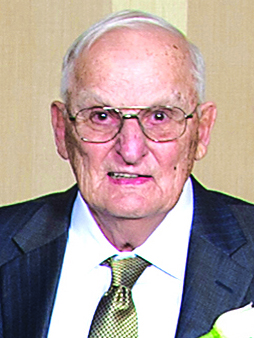Paul E. Petty
Vice President, Retired
Perkin-Elmer Corporation
BSAE 1953
"Most Aero courses were taught at the Airport; those in other schools had special Aero Sections. The Labs were unique in that students were given a handbook, told to get organized, schedule the labs and prepare a final report. This experience, mimicking industry, provided a seamless transition from school to work and was a tremendous help in launching my career. Of course it didn't hurt that my Boss was an Aero grad as well two of my co-workers."
Mr. Paul E. Petty graduated from Purdue University with a Bachelor of Science in Aeronautical Engineering in 1953. Born on a farm in Southern Indiana, he volunteered for the Navy, trained as a fighter pilot flying the famed Corsair. Mr. Petty did graduate studies in Modern Physics and Thermodynamics.
In 1960, Mr. Petty moved from Chance Vought Aircraft to GE's Missile and Space Division and was introduced to the "Black World Programs." The actual name of these programs was Sensitive Compartmented Information (SCI). The key word is compartmented. Work was performed in separate SCI/F facilities, closed off to everybody else; isolated. Information went in; nothing came out, including hardware. What went on in the compartment could not be discussed anywhere, anytime, to anyone, outside the compartment. Mr. Petty spent the next 35 years inside Black Programs in the design, fabrication and operation of optical systems for space applications. An expert in Space Thermo-Physics, he is recognized as a pioneer of space reconnaissance.
At GE's Missile & Space Division, Mr. Petty was Manager of Thermodynamics at the Advanced Projects Department, where he was responsible for thermal design of the KH-7 GAMBIT* space vehicle, camera and electronics. GAMBIT was capable of taking high resolution, less than 2-ft, photos of specific targets from space. The first of 38 flights was in July 1963.
Joining Perkin-Elmer in 1968, Mr. Petty was Project Engineer for the first flight HEXAGON camera system. The Hexagon mission provided photos that were never more than six months old of all Sino-Soviet urban areas, and were never more than 12 months old of all non-urban areas. The first of 20 flights was in June 1971.
Mr. Petty was promoted to Hexagon Program Manager in 1973 and in 1975 he was elected Vice President of the Perkin-Elmer Corporation and General Manager of the Optical Technology Division (The Hexagon SCIF) in Danbury, Conn. The SCIF was a "state of the art," comprehensive stand-alone facility especially created to produce large optical systems for space operation.
Mr. Petty was responsible for the proposal that resulted in the award of the Optical Telescope Assembly for the Large Space Telescope (Hubble) to Perkin-Elmer in Oct 1977.

